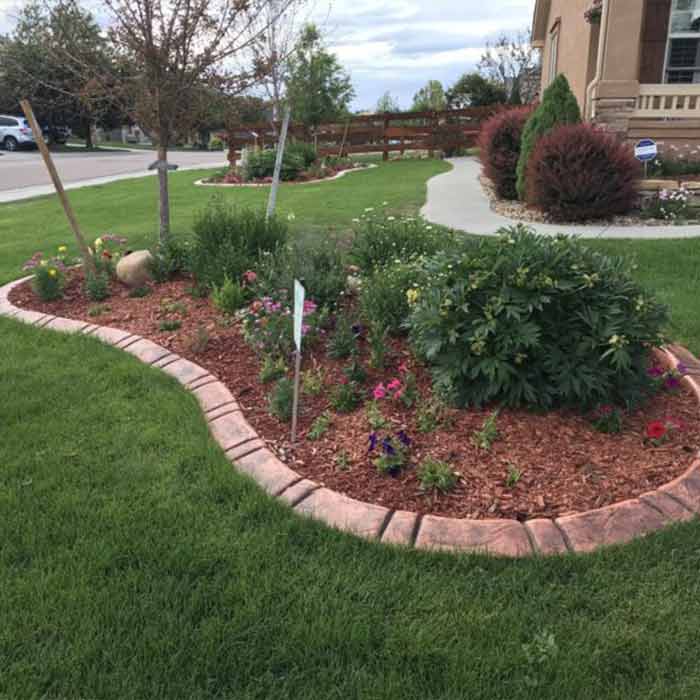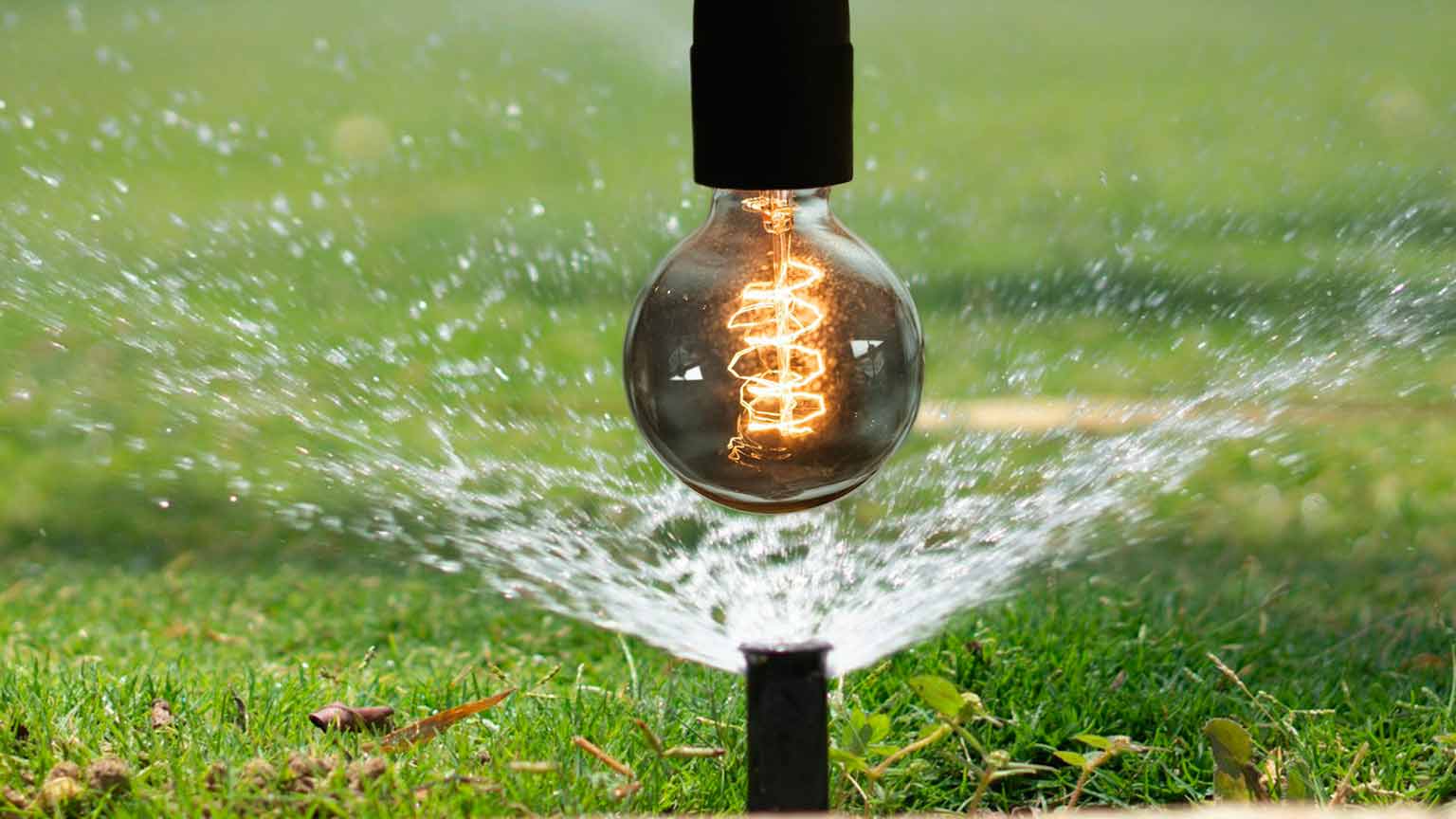The landscape irrigation industry has undergone a revolutionary transformation in recent years, driven by advances in innovative technology, environmental concerns, and rising water costs. Today’s homeowners and businesses are increasingly turning to intelligent sprinkler systems that promise significant water savings while maintaining lush, healthy landscapes. These cutting-edge systems represent a perfect fusion of convenience, conservation, and cost-effectiveness that traditional irrigation methods cannot match.
The Evolution of Irrigation Technology
From Manual to Magnificent
Traditional sprinkler systems have served properties well for decades, but they operate on predetermined schedules regardless of weather conditions, soil moisture, or plant needs. This approach often leads to overwatering during rainy periods and potential underwatering during dry spells. Innovative sprinkler systems eliminate these inefficiencies by incorporating real-time data and automated decision-making processes.
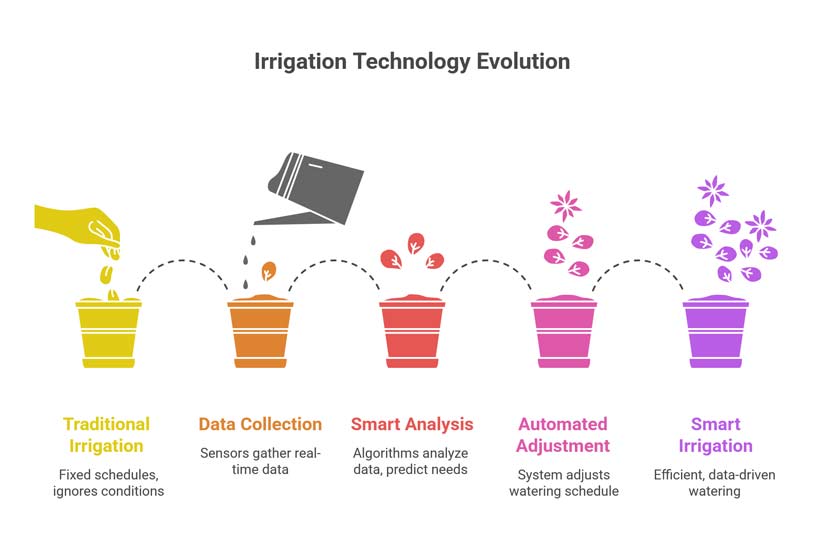
The Smart Difference
Smart irrigation controllers use various sensors, weather data, and sophisticated algorithms to determine exactly when and how much to water your landscape. These systems can adjust watering schedules based on:
- Current weather conditions
- Weather forecasts
- Soil moisture levels
- Plant water requirements
- Evapotranspiration rates
- Historical weather patterns
Core Technologies Behind Smart Sprinkler Systems
Weather-Based Intelligence
Modern smart controllers connect to local weather stations and online weather services to access real-time meteorological data. This connectivity allows the system to automatically skip watering cycles when rain is forecasted or detected, preventing unnecessary water waste. Advanced systems can even adjust for factors like wind speed, humidity, and temperature fluctuations.
Soil Moisture Sensors
How They Work
Soil moisture sensors represent one of the most crucial components of intelligent irrigation systems. These devices measure the actual water content in the soil, providing precise data about whether watering is necessary. The sensors use various technologies:
- Capacitive sensors measure the dielectric constant of soil
- Resistive sensors detect electrical conductivity changes
- Tensiometric sensors measure soil water tension
Strategic Placement
Proper sensor placement is critical for optimal system performance. Sensors should be installed at various depths and locations throughout the landscape to account for:
- Different plant root zones
- Soil type variations
- Slope and drainage patterns
- Sun exposure differences
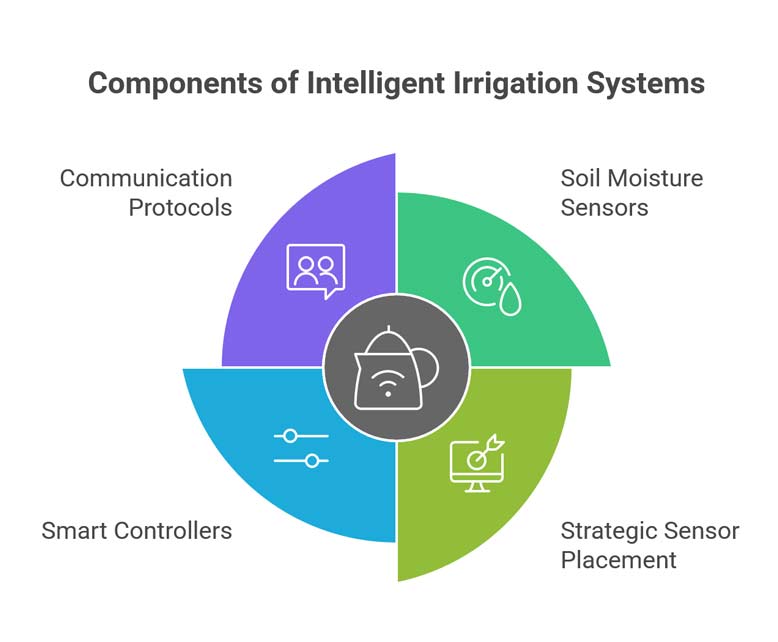
Smart Controllers and Connectivity
WiFi-Enabled Control Hubs
The heart of any innovative sprinkler system is its controller, which processes data from multiple sources and makes watering decisions. Modern controllers offer:
- Remote smartphone app control
- Cloud-based data storage and analysis
- Integration with home automation systems
- Real-time system monitoring and alerts
Communication Protocols
Intelligent irrigation systems utilize various communication methods to ensure reliable operation:
- WiFi connectivity for internet access and remote control
- Zigbee or Z-Wave for local device communication
- Cellular backup for areas with unreliable internet
- Bluetooth for local setup and troubleshooting
Water Conservation Benefits
Quantifiable Savings
Innovative sprinkler systems typically reduce water consumption by 20-50% compared to traditional timer-based systems. The exact savings depend on several factors:
| System Type | Average Water Savings | Annual Cost Savings* |
|---|---|---|
| Weather-Based ET Controller | 15-25% | $150-$400 |
| Soil Moisture Sensor System | 25-35% | $300-$600 |
| Comprehensive Smart System | 35-50% | $500-$1,000 |
*Based on average residential irrigation costs in Colorado
Environmental Impact
The environmental benefits extend far beyond individual water savings:
- Reduced strain on municipal water systems
- Lower energy consumption for water treatment and delivery
- Decreased runoff and erosion
- Improved groundwater conservation
- Reduced chemical fertilizer leaching
Precision Watering Techniques
Zone-Specific Management
Innovative systems excel at managing different landscape zones with varying water requirements. The technology allows for:
- Hydrozoning: Grouping plants with similar water needs
- Microclimate adaptation: Adjusting for sun/shade variations
- Seasonal scheduling: Automatically changing watering patterns throughout the year
- Plant-specific programming: Customizing irrigation for different plant types
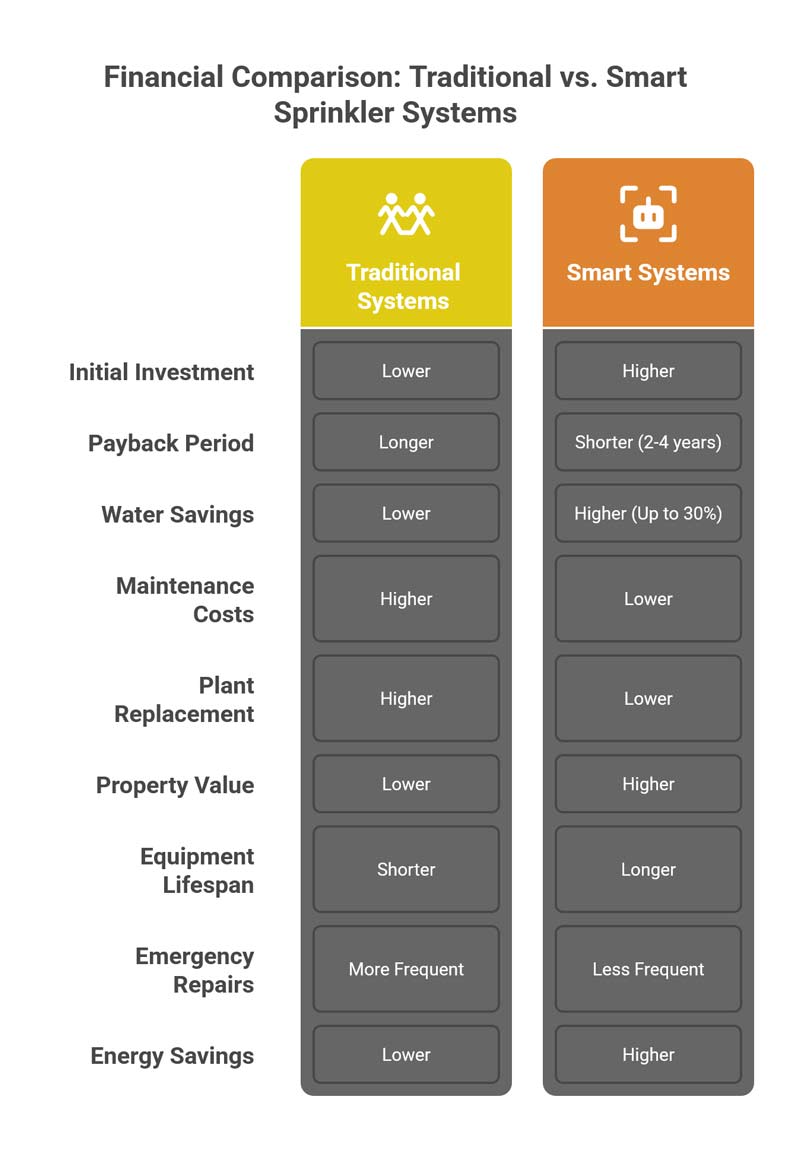
Financial Benefits and Return on Investment
Initial Investment Considerations
While innovative sprinkler systems require a higher upfront investment than traditional systems, the long-term financial benefits are substantial. Typical costs include:
- Intelligent controller: $200-$800
- Soil moisture sensors: $50-$150 per sensor
- Weather station: $100-$300
- Professional installation: $500-$1,500
- System integration: $200-$500
Calculating Payback Period
Most homeowners recover their initial investment within 2-4 years through water savings alone. Additional benefits that improve ROI include:
- Reduced landscape maintenance costs
- Lower plant replacement expenses
- Increased property value
- Potential utility rebates and incentives
Sample ROI Calculation
For a typical Colorado home with a $1,200 annual irrigation bill:
- Smart system cost: $2,500
- Annual water savings (30%): $360
- Reduced maintenance: $200
- Total annual savings: $560
- Payback period: 4.5 years
Long-Term Economic Advantages
Beyond the initial payback period, intelligent irrigation systems continue delivering value through:
- Extended equipment lifespan due to optimized operation
- Reduced emergency repairs from system monitoring
- Energy savings from more efficient pump operation
- Landscape health improvements reduce replacement costs
Advanced Features and Capabilities
Machine Learning and AI Integration
The latest innovative irrigation systems incorporate artificial intelligence to improve performance continuously:
Predictive Analytics
AI algorithms analyze historical data to predict optimal watering schedules, accounting for:
- Seasonal plant growth patterns
- Long-term weather trends
- Soil condition changes
- System performance optimization
Adaptive Learning
Modern systems learn from their environment and adjust automatically:
- Microclimatic adaptation: Fine-tuning based on specific site conditions
- Plant health optimization: Adjusting watering based on plant response
- Efficiency improvements: Continuously optimizing for maximum water savings
Remote Monitoring and Control
Smartphone Applications
Comprehensive mobile apps provide unprecedented control over irrigation systems:
- Real-time system status monitoring
- Remote schedule adjustments
- Water usage tracking and analytics
- Alert notifications for system issues
- Historical data analysis and reporting
Professional Monitoring Services
Many innovative irrigation providers offer professional monitoring services that include:
- 24/7 system surveillance
- Proactive maintenance alerts
- Performance optimization recommendations
- Technical support and troubleshooting
Integration with Smart Home Ecosystems
Popular Platform Compatibility
Innovative sprinkler systems integrate seamlessly with major home automation platforms:
- Amazon Alexa for voice control
- Google Assistant for smart home integration
- Apple HomeKit for iOS users
- Samsung SmartThings for comprehensive automation
Automated Coordination
Advanced integration allows for sophisticated automation scenarios:
- Pool filling coordination to prevent pressure drops
- Landscape lighting synchronization
- Security system integration for enhanced protection
- Energy management coordination with solar systems
Installation and Maintenance Considerations
Professional vs. DIY Installation
Professional Installation Benefits
While homeowners can install some innovative irrigation components, professional installation offers significant advantages:
- Proper system design for optimal coverage and efficiency
- Expert sensor placement for accurate readings
- Integration expertise with existing landscape features
- Warranty protection and ongoing support
- Code compliance, ensuring all installations meet local requirements
DIY Considerations
Homeowners considering self-installation should evaluate: The technical complexity of their chosen system.
- Electrical work requirements for controller installation
- Plumbing modifications needed for sensor integration
- Programming complexity for optimal operation
Ongoing Maintenance Requirements
Regular Maintenance Tasks
Intelligent irrigation systems require periodic maintenance to ensure optimal performance:
- Monthly sensor cleaning to prevent accuracy issues
- Quarterly system testing to verify proper operation
- Seasonal schedule adjustments for changing plant needs
- Annual professional inspection for comprehensive system evaluation
Troubleshooting Common Issues
Understanding common problems helps maintain system reliability:
- WiFi connectivity issues: Often resolved by router placement or range extenders
- Sensor calibration drift: Requires periodic recalibration or replacement
- Software update conflicts: Regular app updates prevent compatibility issues
- Physical damage: Weather and landscape maintenance can affect components
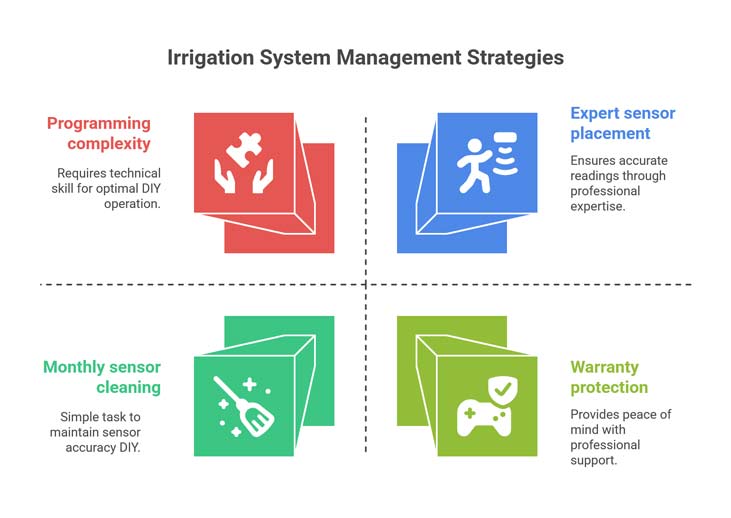
Seasonal Optimization Strategies
Spring Startup Procedures
Proper spring activation ensures optimal system performance:
- System inspection for winter damage
- Sensor recalibration after freeze-thaw cycles
- Schedule adjustments for changing daylight hours
- Software updates to the latest firmware versions
Winter Preparation
Cold climate preparation protects system investments:
- Pipe drainage to prevent freeze damage
- Sensor protection from extreme temperatures
- Controller settings for dormant season operation
- Component winterization following manufacturer guidelines
Choosing the Right Smart Sprinkler System
Assessing Your Landscape Needs
Property Evaluation Factors
Selecting the optimal innovative irrigation system requires careful consideration of:
- Landscape size and complexity
- Plant diversity and water requirements
- Soil types and drainage characteristics
- Climate conditions and weather patterns
- Existing irrigation infrastructure
Water Source Analysis
Understanding your water supply helps optimize system design:
- Municipal water pressure and flow rates
- Well system capacity and reliability
- Water quality considerations affecting equipment selection
- Seasonal availability and restriction schedules
Feature Prioritization
Essential vs. Advanced Features
Budget-conscious consumers should prioritize features based on their specific needs:
Essential Features:
- Weather-based scheduling
- Remote smartphone control
- Basic soil moisture monitoring
- Water usage tracking
Advanced Features:
- AI-powered optimization
- Professional monitoring services
- Comprehensive sensor networks
- Integration with home automation
Scalability Considerations
Intelligent irrigation systems should accommodate future expansion:
- Modular design allowing component additions
- Software flexibility for feature upgrades
- Compatibility with emerging technologies
- Professional support for system modifications
Regional Considerations for Colorado
Climate-Specific Challenges
Colorado’s unique climate presents specific irrigation challenges that innovative systems address effectively:
High Altitude Effects
Elevation impacts irrigation requirements through:
- Increased evaporation rates due to lower air pressure
- Intense UV exposure affects plant water needs
- Rapid temperature fluctuations require adaptive scheduling
- Variable precipitation patterns demand flexible programming
Seasonal Extremes
Colorado’s dramatic seasonal changes require sophisticated system responses:
- Late spring freezes potentially damage new growth
- Sudden summer storms provide an irregular water supply
- Extended dry periods require careful water management
- Early fall frosts necessitate season-end adjustments
Local Water Regulations
Municipal Restrictions
Many Colorado municipalities impose irrigation restrictions that intelligent systems can automatically accommodate:
- Odd/even day scheduling based on address
- Time-of-day limitations to reduce peak demand
- Seasonal prohibitions during drought conditions
- Flow rate restrictions for water conservation
Utility Incentive Programs
Local utilities often provide rebates for innovative irrigation installations:
- Equipment rebates reduce initial costs
- Installation incentives for professional service
- Performance bonuses for demonstrated water savings
- Ongoing credits for participating in demand management programs
“Smart irrigation technology represents the most significant advancement in landscape water management since the invention of the automatic sprinkler valve. These systems don’t just save water; they save time, money, and help create healthier landscapes that thrive in Colorado’s challenging climate.” – Chad Livingston, Owner of A Better Edge
Future Trends and Innovations
Emerging Technologies
Satellite Integration
Next-generation innovative irrigation systems are beginning to incorporate satellite data for:
- Precise weather forecasting using high-resolution imagery
- Vegetation health monitoring through spectral analysis
- Drought condition assessment for proactive water management
- Large-scale climate pattern analysis improves long-term planning
Advanced Sensor Networks
Future systems will feature expanded sensor capabilities:
- Plant stress sensors detecting early drought symptoms
- Nutrient monitoring to optimize fertilizer application
- Pest detection enabling integrated pest management
- Air quality sensors are adjusting watering for environmental conditions
Sustainability Integration
Renewable Energy Power
Solar-powered irrigation controllers are becoming increasingly viable:
- Battery backup systems ensure continuous operation
- Energy harvesting from multiple renewable sources
- Grid-tie capabilities for net energy production
- Carbon footprint reduction supporting environmental goals
Water Recycling Integration
Intelligent systems are evolving to incorporate alternative water sources:
- Rainwater harvesting systems with automated management
- Greywater recycling for sustainable landscape irrigation
- Condensate recovery from HVAC systems
- Stormwater management integration for comprehensive water stewardship
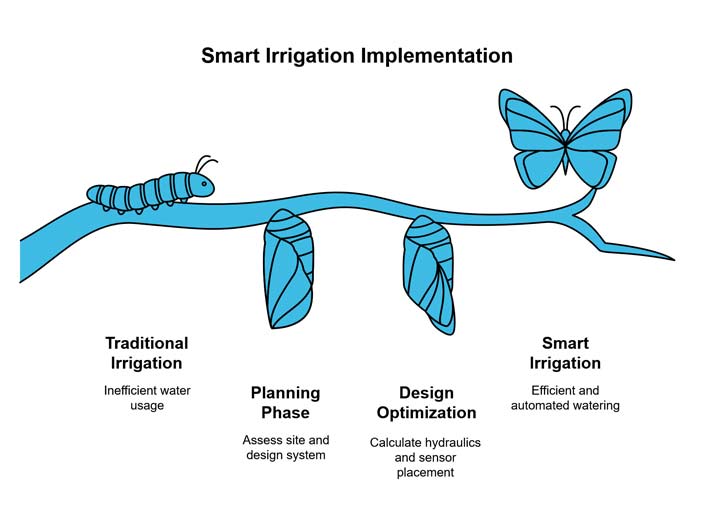
Implementation Strategy and Best Practices
Planning Phase
Site Assessment Procedures
Successful smart irrigation implementation begins with comprehensive planning:
- Detailed landscape mapping identifying all irrigation zones
- Soil analysis determining water retention characteristics
- Plant inventory cataloging species and water requirements
- Existing system evaluation assessing upgrade opportunities
- Budget development, including all project phases
Design Optimization
Professional system design ensures maximum efficiency:
- Hydraulic calculations for proper water distribution
- Sensor placement strategy for accurate monitoring
- Controller specifications matching system requirements
- Expansion planning for future landscape changes
Installation Best Practices
Quality Assurance Measures
Professional installation includes multiple quality checkpoints:
- Component verification, ensuring all equipment meets specifications
- System testing, validating proper operation before activation
- Programming verification confirming schedule accuracy
- User training providing comprehensive operation instructions, Documentation, and requirements. Proper documentation supports long-term system success:
- As-built drawings showing final installation details
- Equipment specifications for future maintenance reference
- Programming parameters documenting initial settings
- Warranty information protecting investment value. Innovative sprinkler systems represent a transformative technology that delivers measurable benefits for property owners while supporting broader environmental conservation goals. The combination of water savings, cost reduction, and improved landscape health makes these systems an increasingly attractive investment for Colorado homeowners and businesses.
The technology continues evolving rapidly, with new features and capabilities emerging regularly. Property owners considering smart irrigation should focus on systems that offer scalability, professional support, and proven performance in Colorado’s unique climate conditions.
For residents across El Paso County, Douglas County, Denver County, Arapahoe County, and Jefferson County, innovative sprinkler technology offers a practical solution for maintaining beautiful landscapes while being responsible stewards of our precious water resources. The initial investment in innovative irrigation technology pays dividends through reduced utility bills, healthier plants, and the satisfaction of contributing to sustainable water management practices.
References:





